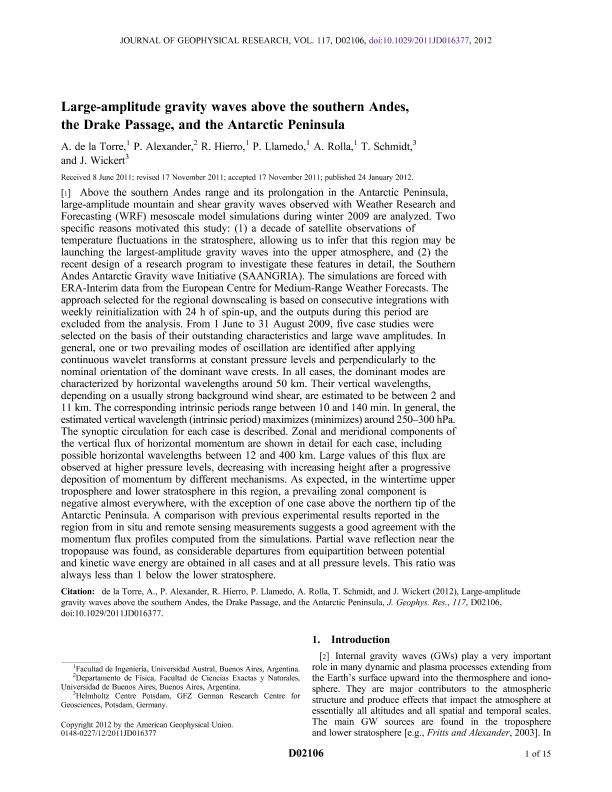Mostrar el registro sencillo del ítem
dc.contributor.author
de la Torre, Alejandro

dc.contributor.author
Alexander, Pedro Manfredo

dc.contributor.author
Hierro, Rodrigo Federico

dc.contributor.author
Llamedo Soria, Pablo Martin

dc.contributor.author
Rolla, Alfredo Luis

dc.contributor.author
Schmidt, T.
dc.contributor.author
Wickert, J.
dc.date.available
2017-06-08T19:32:20Z
dc.date.issued
2012-01
dc.identifier.citation
de la Torre, Alejandro; Alexander, Pedro Manfredo; Hierro, Rodrigo Federico; Llamedo Soria, Pablo Martin; Rolla, Alfredo Luis; et al.; Large-amplitude gravity waves above the southern Andes, the Drake Passage, and the Antarctic Peninsula; American Geophysical Union; Journal Of Geophysical Research; 117; D2; 1-2012; 1-15
dc.identifier.issn
0148-0227
dc.identifier.uri
http://hdl.handle.net/11336/17806
dc.description.abstract
Above the southern Andes range and its prolongation in the Antarctic Peninsula, large-amplitude mountain and shear gravity waves observed with Weather Research and Forecasting (WRF) mesoscale model simulations during winter 2009 are analyzed. Two specific reasons motivated this study: (1) a decade of satellite observations of temperature fluctuations in the stratosphere, allowing us to infer that this region may be launching the largest-amplitude gravity waves into the upper atmosphere, and (2) the recent design of a research program to investigate these features in detail, the Southern Andes Antarctic Gravity wave Initiative (SAANGRIA). The simulations are forced with ERA-Interim data from the European Centre for Medium-Range Weather Forecasts. The approach selected for the regional downscaling is based on consecutive integrations with weekly reinitialization with 24 h of spin-up, and the outputs during this period are excluded from the analysis. From 1 June to 31 August 2009, five case studies were selected on the basis of their outstanding characteristics and large wave amplitudes. In general, one or two prevailing modes of oscillation are identified after applying continuous wavelet transforms at constant pressure levels and perpendicularly to the nominal orientation of the dominant wave crests. In all cases, the dominant modes are characterized by horizontal wavelengths around 50 km. Their vertical wavelengths, depending on a usually strong background wind shear, are estimated to be between 2 and 11 km. The corresponding intrinsic periods range between 10 and 140 min. In general, the estimated vertical wavelength (intrinsic period) maximizes (minimizes) around 250–300 hPa. The synoptic circulation for each case is described. Zonal and meridional components of the vertical flux of horizontal momentum are shown in detail for each case, including possible horizontal wavelengths between 12 and 400 km. Large values of this flux are observed at higher pressure levels, decreasing with increasing height after a progressive deposition of momentum by different mechanisms. As expected, in the wintertime upper troposphere and lower stratosphere in this region, a prevailing zonal component is negative almost everywhere, with the exception of one case above the northern tip of the Antarctic Peninsula. A comparison with previous experimental results reported in the region from in situ and remote sensing measurements suggests a good agreement with the momentum flux profiles computed from the simulations. Partial wave reflection near the tropopause was found, as considerable departures from equipartition between potential and kinetic wave energy are obtained in all cases and at all pressure levels. This ratio was always less than 1 below the lower stratosphere.
dc.format
application/pdf
dc.language.iso
eng
dc.publisher
American Geophysical Union

dc.rights
info:eu-repo/semantics/openAccess
dc.rights.uri
https://creativecommons.org/licenses/by-nc-sa/2.5/ar/
dc.subject
Mountain Waves
dc.subject
Andesmountains
dc.subject
Peninsula Antarctica
dc.subject.classification
Otras Ciencias de la Tierra y relacionadas con el Medio Ambiente

dc.subject.classification
Ciencias de la Tierra y relacionadas con el Medio Ambiente

dc.subject.classification
CIENCIAS NATURALES Y EXACTAS

dc.title
Large-amplitude gravity waves above the southern Andes, the Drake Passage, and the Antarctic Peninsula
dc.type
info:eu-repo/semantics/article
dc.type
info:ar-repo/semantics/artículo
dc.type
info:eu-repo/semantics/publishedVersion
dc.date.updated
2017-05-31T19:44:41Z
dc.journal.volume
117
dc.journal.number
D2
dc.journal.pagination
1-15
dc.journal.pais
Estados Unidos

dc.journal.ciudad
Washington DC
dc.description.fil
Fil: de la Torre, Alejandro. Universidad Austral. Facultad de Ingeniería; Argentina. Consejo Nacional de Investigaciones Científicas y Técnicas; Argentina
dc.description.fil
Fil: Alexander, Pedro Manfredo. Universidad de Buenos Aires. Facultad de Ciencias Exactas y Naturales. Departamento de Física; Argentina. Consejo Nacional de Investigaciones Científicas y Técnicas; Argentina
dc.description.fil
Fil: Hierro, Rodrigo Federico. Universidad Austral. Facultad de Ingeniería; Argentina. Consejo Nacional de Investigaciones Científicas y Técnicas; Argentina
dc.description.fil
Fil: Llamedo Soria, Pablo Martin. Universidad Austral. Facultad de Ingeniería; Argentina. Consejo Nacional de Investigaciones Científicas y Técnicas; Argentina
dc.description.fil
Fil: Rolla, Alfredo Luis. Universidad Austral. Facultad de Ingeniería; Argentina. Consejo Nacional de Investigaciones Científicas y Técnicas; Argentina
dc.description.fil
Fil: Schmidt, T.. Helmholtz Centre Potsdam; Alemania
dc.description.fil
Fil: Wickert, J.. Helmholtz Centre Potsdam; Alemania
dc.journal.title
Journal Of Geophysical Research

dc.relation.alternativeid
info:eu-repo/semantics/altIdentifier/doi/http://dx.doi.org/10.1029/2011JD016377
dc.relation.alternativeid
info:eu-repo/semantics/altIdentifier/url/http://onlinelibrary.wiley.com/doi/10.1029/2011JD016377/abstract
Archivos asociados
